Serenading a mesh of musical folk in Accra…by PaJohn Dadson
Serenading a mesh of musical folk in Accra…by PaJohn Dadson
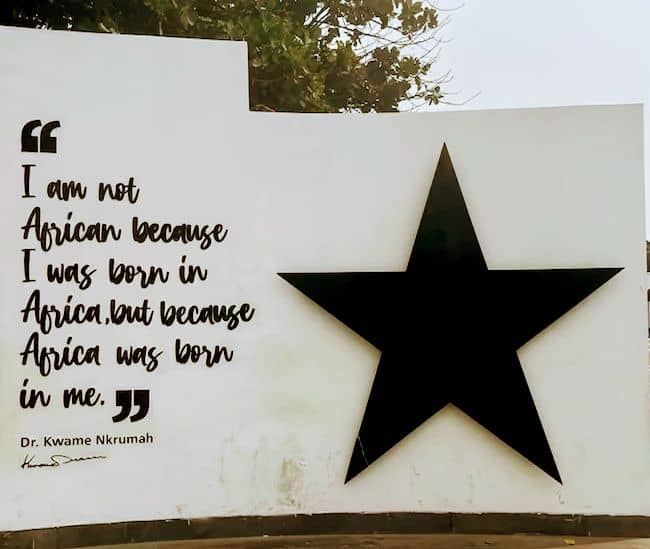

For all the knowledge shared and the other intrinsic things derived from those interactions, I do so love chaperoning matured folk. So, when my big brother friend, Nenyi, as in Quaison-Sackey, one person I consider as such (and sophisticated too), suggested that I handle a group he intended bringing to town, I quickly jumped at the opportunity.
Having lived most of his life, from infancy, abroad, moving around continents with his diplomat dad, Nenyi, makes fine company. A bassist, as in a jazz musician of international repute, I figured any group he constitutes to bring home to Ghana for a visit would have a crop of refined people with whom I could flow with my discourse. I wasn’t wrong.
The Group
I was super thrilled to discover that the group consisted of the legendary American jazz musician, Vinx, and some friends. Not only does he have successful albums to his credit, but Vinx, a virtuoso percussionist, singer and songwriter, has been many other things in his 66 years, including having played and toured the world with Stevie Wonder, Herbie Hancock and Sting, and is also a former professional athlete.
Now making his home in Cannes, a resort town on the French Riviera, Vinx was for the first time, coming to host his ‘International Serenade Festival’, a “gathering of musicians, artists, dancers and designers to celebrate the power of love” in Africa.
The festival had taken a hiatus after COVID, and when he picked it up again, he was geared up for an African adventure!
Consumate, passionate, grand, Vinx shares his immense knowledge with enthusiastic “lovers and artists” from around the globe who make an annual pilgrimage to join his workshops, hosted in locations that inspire with their history, beauty and ambiance.
Given that criteria, Ghana was an obvious choice as the destination for the festival. History, beauty, and ambience being in abundance, all that is needed is a spirited, knowledgeable guide who could bring the country alive. Nenyi thought I would fit that bill easily and told Vinx.
It was an anxious and excited group of 12 altogether, most of whom had also only just met, that I picked up from the lobby of Alisa Hotel at North Ridge in Accra for the orientation city tour. Before long, though, they were responding appropriately to my attention-drawing traditional call of “Agoo o” with the required response of “Ameeh”.
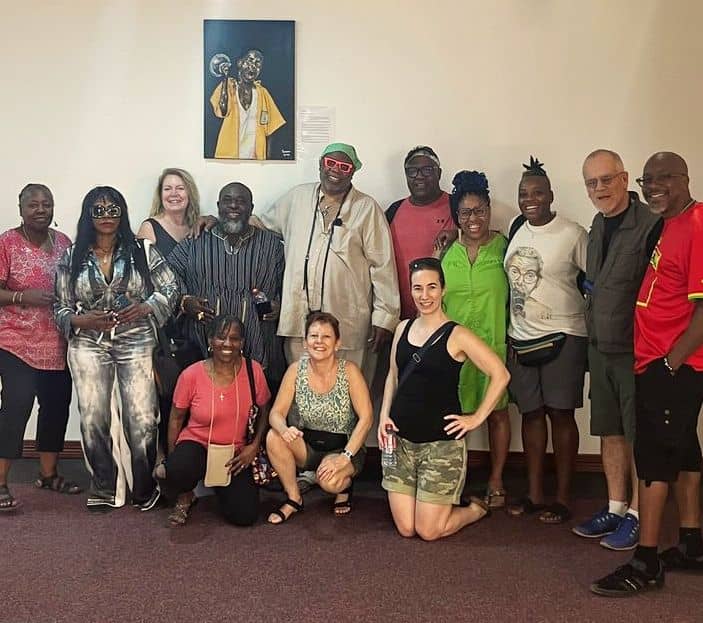
Seeing Accra
As I expected, we hit it off, and circling the Central Business District downtown and cruising along the Ring Road, by the time we went up the overhead bridge at the Kwame Nkrumah Intersection, past the 200-year old Awudome Cemetery, down past the Central Mosque at the second-hand car parts dealership hub at Abbosey Okai, down the mile-long ride beside the smoke-ridden heaps of dross at Agbogbloshie, past the state mortuary and the neem tree-lined avenue at Korle Bu Hospital, making that left turn at the coast at “Lavender Hill”, past where the debris of the city collects as the Korle Lagoon enters the Atlantic Ocean, joining the High Street at Mantse Agbona in Jamestown, and getting all the commentary and narratives that set the tone for the tour, we felt like old primary school mates at our annual reunion.
By the time they returned from the on-site tour of the Kwame Nkrumah Memorial Park, where they got acquainted with Ghana’s greatest Pan Africanist gift to the world and BBC’s Man of the Millennium, our first President, Osagyefo Dr Kwame Nkrumah, and his contributions in creating the nation-state Ghana, we were on first-name terms, slapping each other casually as we chatted.
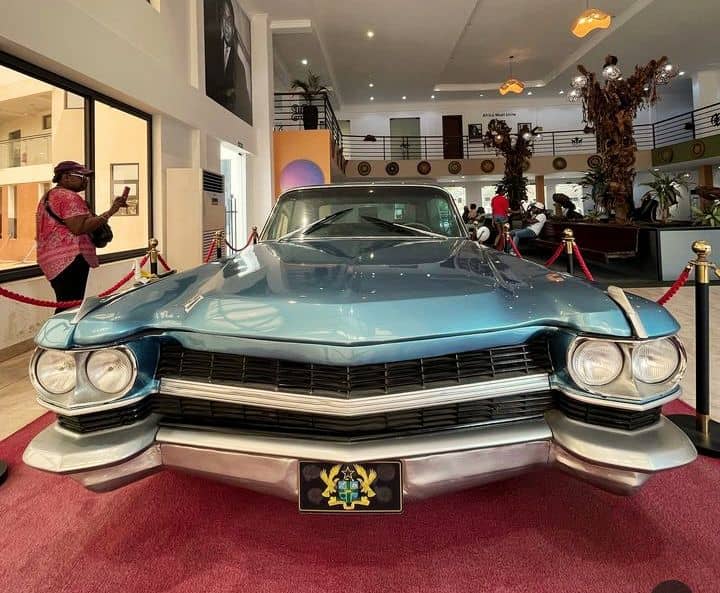
Cue the creation of social media-worthy photo ops at Black Star Gate, a majestic arch and parting gift from our British colonisers, that stands as one of our country’s most iconic images inscribed with our nation’s motto; “Freedom & Justice” (which Kwame Nkrumah had etched in later) and “AD 1957”, the year of our independence.
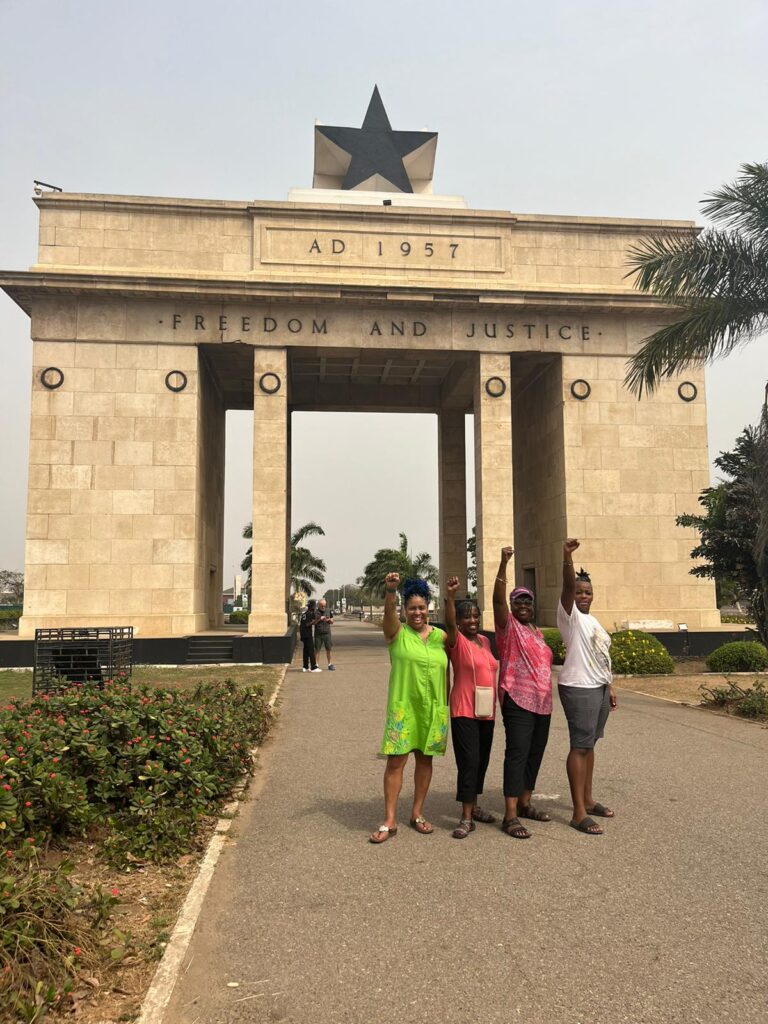
Across from it, at Black Star Square – with an area of 1,057,238 square feet, easily the largest public parade grounds in Africa – some more memories were made taking pictures of the monument of the unknown soldier and the pit where the perpetual flame is lit during national ceremonies.
Having shown them old Accra, and the trading hub of the city, pointing out the industrial section, and now the ceremonial part downtown, we drove through the most cosmopolitan part of town along Oxford Street to the upmarket residential Cantonments area, up the new airport bypass to the Spintex area, through East Legon, Adenta and up to Abokobi.
I was eager to get them to what is, for me, the highlight of this particular tour – Capital Delights by WangoWango – a visit to a little-known exhibition at an obscure town north of Accra, where a plantation established by the Danes in 1831 tells the story of how life with settler European colonizers was, further inland.
Fort Frederiksgave
The story is told of how the Danish governor, on behalf of their government, purchased the ‘deed’ for a newly-established plantation (the Beehive) set in the Akwapim range at Seseme, near the town of Abokobi, a few kilometres north of Legon, a bit further on from Accra.
The purchase included the thirty-two enslaved workers that belonged to it. The Danes renamed it ‘Frederiksgave’ after the Danish king at the time, Frederik VI. ‘Gave’ is the Danish word for ‘gift’, so Frederiksgave literally means “Frederik’s gift”. Following later purchases of land, it covered 163 acres.
Apart from a main building, which was still under construction, there was a small village with twelve houses, later expanded to 20, where the slaves lived. And, to improve access to the coast, an avenue to Osu, flanked by tamarind trees imported from India, was constructed. In fact, from the balcony at the main building, which is atop the hill, you can see as far as the Atlantic Ocean miles away.
Though the plantation experimented with others, the main crop grown at Frederiksgave was coffee. 5,000 plants existed in 1834. In 1836, however, the governor at the time, Mørch, was forced to report that experiments growing coffee, sugarcane, tobacco, indigo, cotton and grapes had all produced such poor results that all plans to develop plantation production in the area would have to be abandoned.
At the time, and later, people discussed whether the failure was due to the climate, poor soil conditions, the unclear rights of ownership, inadequate political stability, the lack of technical knowledge of the plantation owners, the inadequate labour input of the slaves and their possibility of escaping, cheaper and more efficient plantation production in other parts of the world, or competition from other local economic activities, such as the production of palm oil by local peasants.
Plantation production continued, albeit on a limited scale, but after 1836, it increasingly became a health resort for ill Danish public servants from Christiansborg Castle, the seat of government. After selling Danish properties to the British in 1850, the buildings decayed, and the local people from the village of Djaben??, situated about 500 yards down the road towards Abokobi, vandalized it by removing materials of its construction for firewood.
With funding from the Danish government, the building has since been restored as a historical exhibition and cultural centre, covering a part of the history of Ghana and Denmark’s cultural heritage. The archeological escavation discovered a truly telling story!
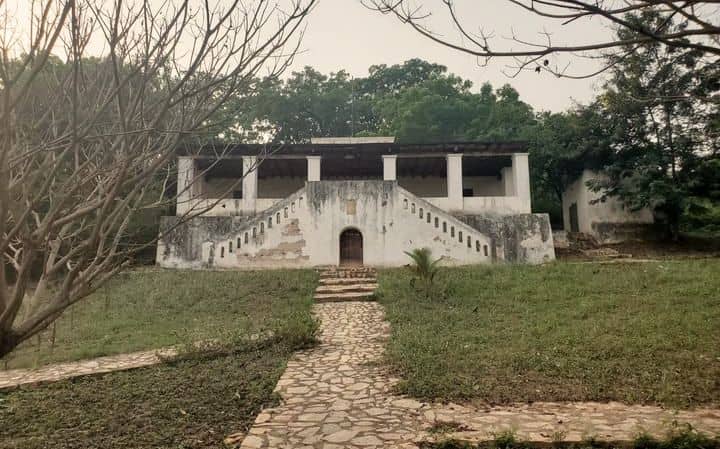
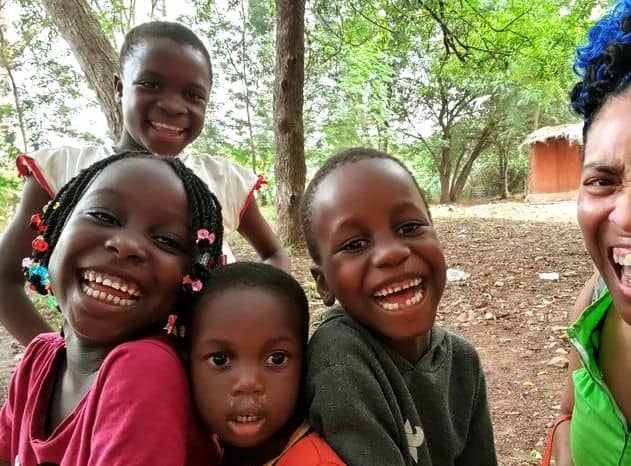
Lunch
If there’s one thing I’ve learnt about travelling with mature people, it’s how they love to linger on at meal times. The reconstructed Fort is sited on a spread of undulating land covered with trees. Although nondescript now, I could see a picnic set up the moment I set my eyes on it a few years ago.
Having sent ahead of our arrival my team, who had already set up a WangoWango base camp on the grounds with our mobile kitchen at one end and a long table with chairs under a portable canopy tent at another, the picturesque display appeared as we ascended the gradient, a short distance ahead.
After immersing in the history and discoveries of the site, we all sat down to a late lunch of grilled “dawadawa” chicken and fish accompanied with some fried yams and gari fortor, all of which went down well along with animated convos.
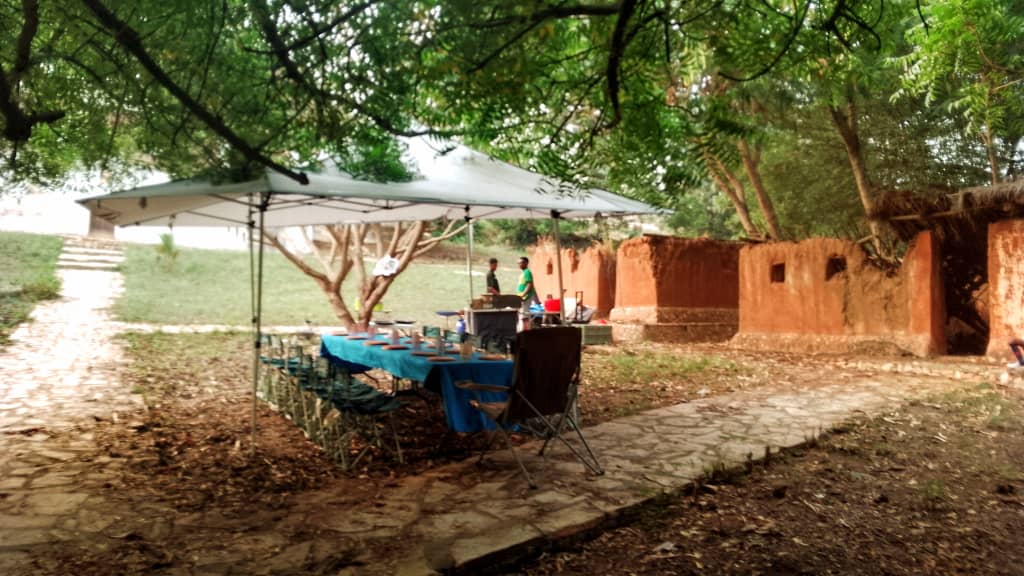
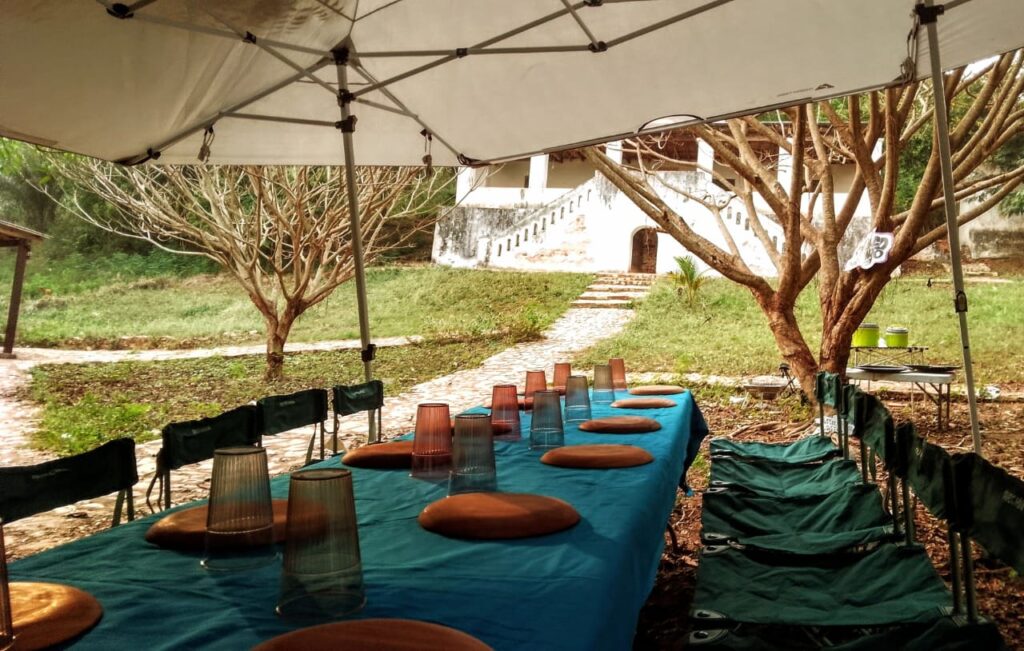
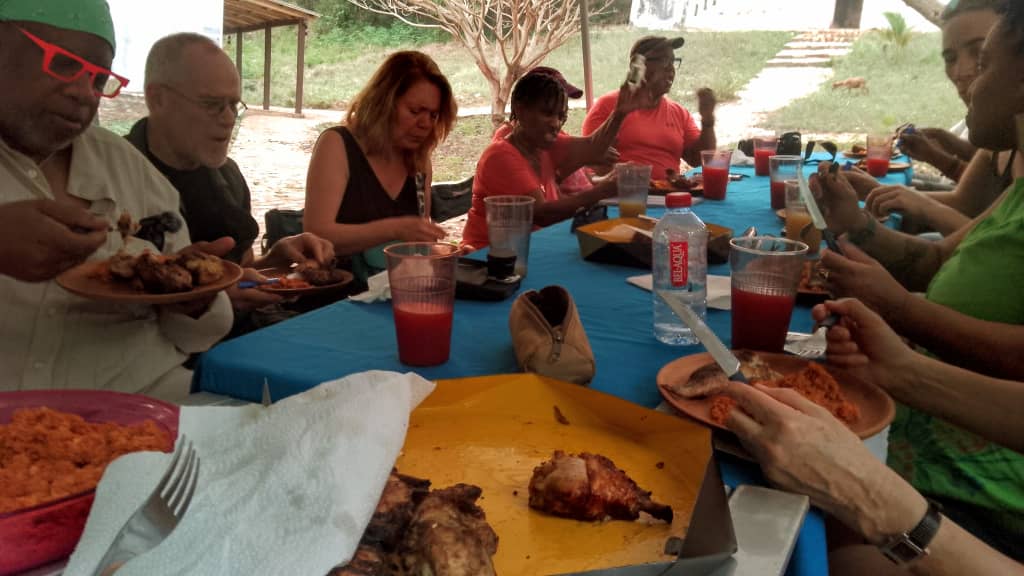
…and Dinner
Back in Accra, dinner was also on the bill and was up on the terrace rooftop at PaJohn’s, a secluded destination for avant garde lounging and dining, nestled in the enclave of Kanda Estate in the heart of the city.
A spread of an array of root tubers, boiled yam, sweet potatoes and plantains, to go with garden eggs and “nkontomire” – cocoyam leaves – blended with peppers, other spices and herbs into the traditional “abom” delicacy, and sitting across from each other at another long table under moonlight, the session that was meant to last some 2 hours easily went double that. Just the goodbyes at the end of the evening alone lasted over 30 minutes, as the enchantment and uniqueness of the meal became a hot topic.
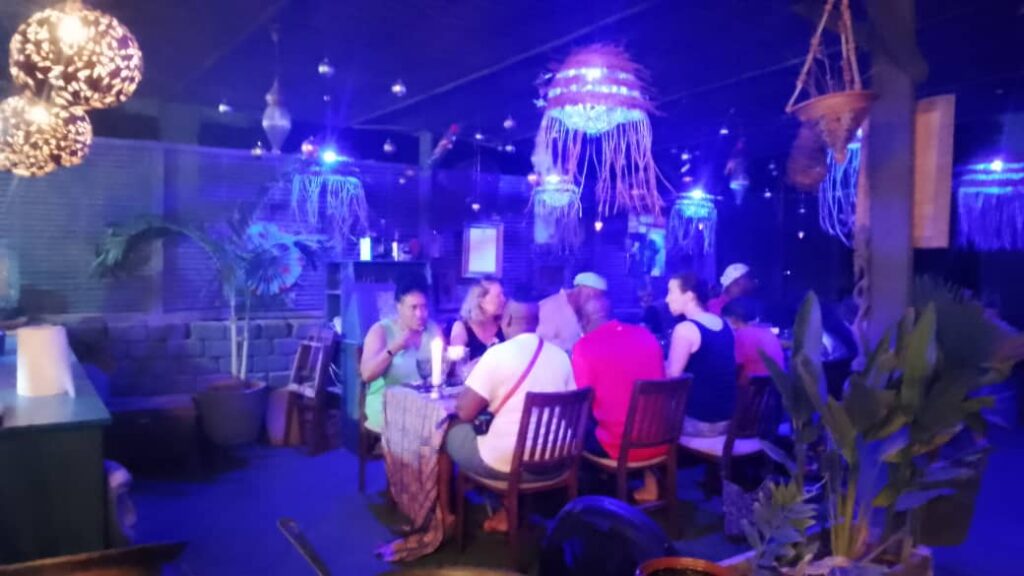
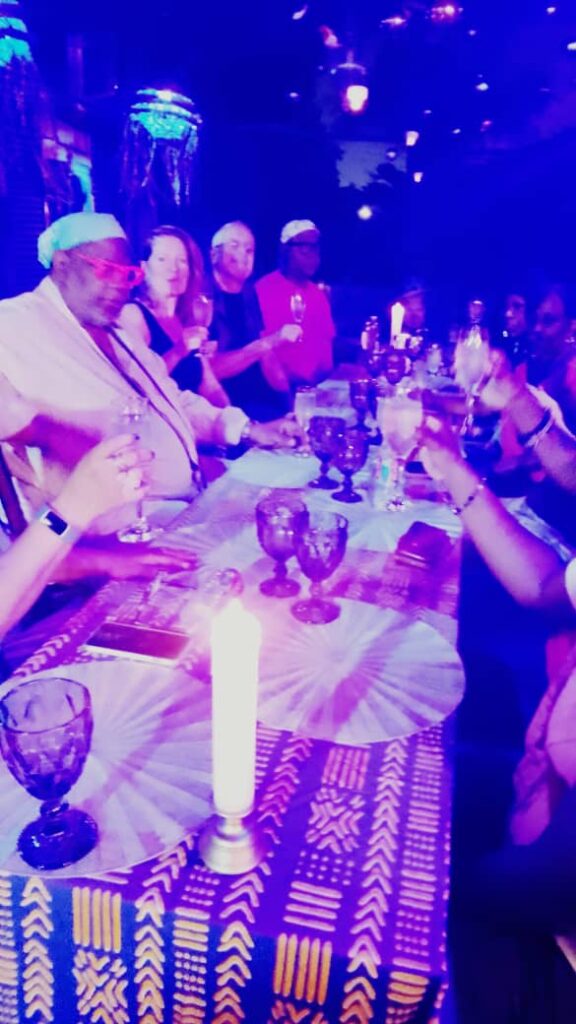
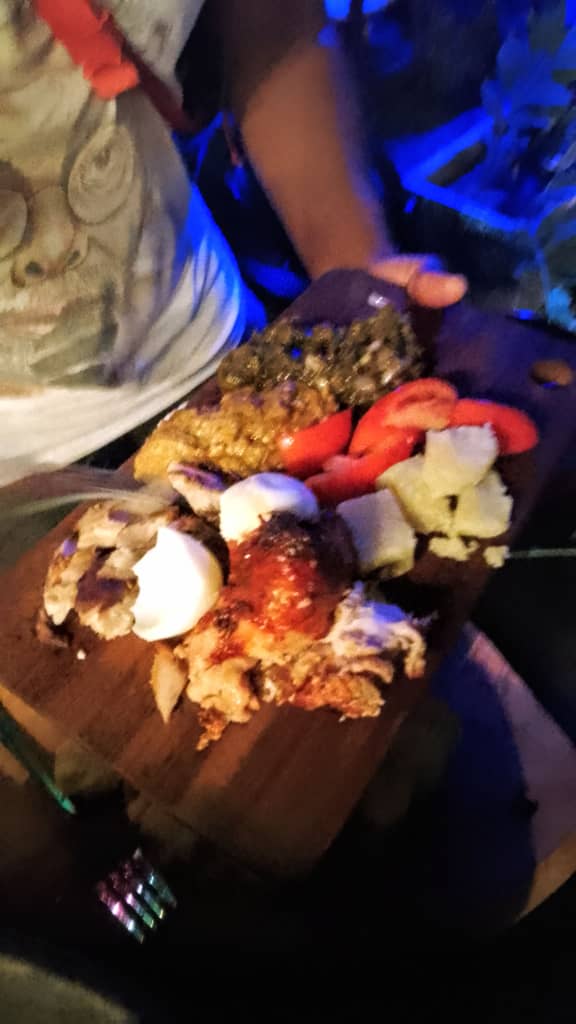
Looking at the pictures now and seeing all the contented smiles, I believe it was a good day that was had.
Let’s plan your next adventure. Contact us on WhatsApp at +233 24 469 7046.



